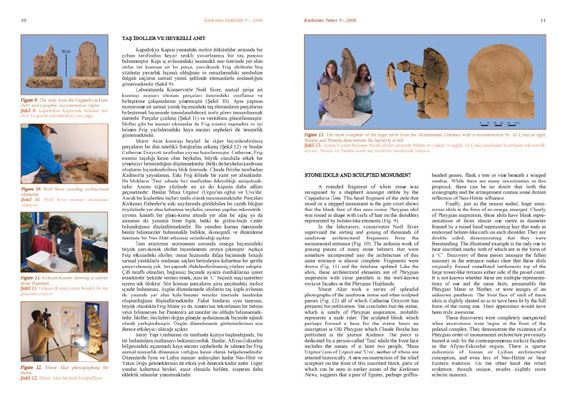STONE
IDOLS AND SCULPTED MONUMENT
A rounded
fragment of white stone was recognised by a shepherd amongst
rubble by the Cappadocia Gate. This head fragment of the stele
that stood on a stepped monument in the gate court shows that
the blank face of this semi-iconic Phrygian idol was round in
shape with curls of hair on the shoulders represented by bolster-like
elements (Fig. 9).
In the laboratory, conservator Noël Siver supervised the
sorting and joining of thousands of sandstone architectural
fragments from the monumental entrance (Fig. 10). The arduous
work of joining pieces of many stone bolsters that were somehow
incorporated into the architecture of this same entrance is
almost complete. Fragments were drawn (Fig. 11) and the database
updated. Like the idols, these architectural elements are of
Phrygian inspiration with close parallels in the well-known
rockcut façades in the Phrygian Highlands.
Murat Akar took a series of splendid photographs of the sandstone
statue and other sculpted pieces (Fig. 12) all of which Catherine
Draycott has prepared for publication. She concludes that the
statue, which is surely of Phrygian inspiration, probably represents
a male ruler. The sculpted block which perhaps formed a base
for the statue bears an inscription in Old Phrygian which Claude
Brixhe has published in the journal Kadmos. The pieces is dedicated
by a person called 'Tata' while the front face includes the
names of at least two people, 'Masa Urgitos' (son of Urgos)
and 'Uva', neither of whom are attested historically. A new
reconstruction of the relief sculpture on the front of this
inscribed block, parts of which can be seen in earlier issues
of the Kerkenes News, suggests that a pair of figures, perhaps
griffin-headed genies, flank a tree or vine beneath a winged
sundisc. While there are many uncertainties in this proposal,
there can be no doubt that both the iconography and the arrangement
contain some distant reflection of Neo-Hittite influence.
Finally, just as the season ended, huge semi-iconic idols in
the form of an omega, emerged. Clearly of Phrygian inspiration,
these idols have blank representations of faces almost one metre
in diameter framed by a raised band representing hair that ends
in embossed bolster-like curls on each shoulder. They are double
sided, demonstrating that they were freestanding. The illustrated
example is the only one to bear inscribed marks both of which
are in the form of a “C”. Discovery of these pieces
amongst the fallen masonry in the entrance makes clear that
these idols originally formed crenellated battlements top of
the large tower-like terraces either side of the paved court.
It is not known whether these are multiple representations of
one and the same deity, presumably the Phrygian Matar or Mother,
or were images of an unknown pantheon. The front face of each
of these idols is slightly slanted so as to have been lit by
the full force of the rising sun. Their appearance would have
been truly awesome.
These discoveries were completely unexpected when excavations
were begun at the front of the palatial complex. They demonstrate
the existence of a Phrygian order of monumental architecture
previously hinted at only by the contemporaneous rockcut façades
in the Afyon-Eskisehir region. There is sparse indication of
Ionian or Lydian architectural conception, and even less of
Neo-Hittite or Near Eastern tradition. On the other hand the
relief sculpture, though unique, exudes slightly more eclectic
nuances.



